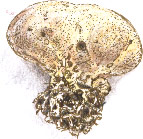 |
Earthball
Saturday, 15th September 2002, West Yorkshire |
![]()
![]()
![]()
![]() Rocks |
History |
Workshop |
Links |
Home Page
Rocks |
History |
Workshop |
Links |
Home Page
![]()

 A small colony, the book refers to it as a 'small troop', of earthball fungus grows on a sparsely grassy verge shaded by birch and hawthorn at the side of the quarry path. Some have irregular holes in the upper surface revealing the powdery dark brown spores inside, like cocoa.
A small colony, the book refers to it as a 'small troop', of earthball fungus grows on a sparsely grassy verge shaded by birch and hawthorn at the side of the quarry path. Some have irregular holes in the upper surface revealing the powdery dark brown spores inside, like cocoa.Like all mushrooms and toadstools, the earthballs are the fruiting bodies; the main part of the plant - the mycelium - grows in the turf below. In my sketch the white rootlike mass is made up of mycelial cords.

This earthball has no common name but it's scientific name Scleroderma areolatum means, if I've translated it correctly, 'hardened skin with small circular dots on it.' The alternative species name lycoperdoides derives from the Greek for 'wolf' and 'to break wind'.
No wonder it is described as 'inedible'.
Common Earthball
 The common earthball (left) has bigger, whiter scales and doesn't have such a dense mass of mycelium attaching it to the ground, just threads and cords.
The common earthball (left) has bigger, whiter scales and doesn't have such a dense mass of mycelium attaching it to the ground, just threads and cords.The book warns; 'Some continental authors advocate use of the young powdered fruiting body (of common earthball) as a condiment but the practice is not to be recommended.'
The Book
I've just started using The Encyclopedia of Fungi of Britain and Europe by Michael Jordan. There are stacks of colour photographs, one thousand in fact, of the species in their natural habitats.
![]()
Richard Bell,
wildlife illustrator
E-mail; 'richard@willowisland.co.uk'
![]() Next page |
Previous page |
This day last year |
This month |
Nature Diary |
Home Page
Next page |
Previous page |
This day last year |
This month |
Nature Diary |
Home Page
![]()